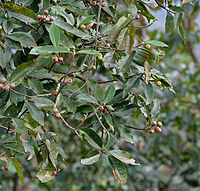Schima: Difference between revisions
New page: __NOTOC__{{Plantbox | name = ''LATINNAME'' <!--- replace LATINNAME with the actual latin name --> | common_names = <!--- if multiple, list all, if none, leave blank --> | growth_habi... |
No edit summary |
||
| (One intermediate revision by one other user not shown) | |||
| Line 1: | Line 1: | ||
{{SPlantbox | |||
| | |familia=Theaceae | ||
| | |genus=Schima | ||
| | |habit=tree | ||
| | |habit_ref=Flora - A Gardener's Encyclopedia | ||
|lifespan=perennial | |||
|life_ref=Flora - A Gardener's Encyclopedia | |||
|features=evergreen | |||
| lifespan = | |Temp Metric=°F | ||
| | |jumpin=If this plant info box on watering; zones; height; etc. is mostly empty you can click on the edit tab and fill in the blanks! | ||
|image=Makrisal (Schima wallichii) leaves & fruit at Samsing, Duars, West Bengal W IMG 5964.jpg | |||
| features = | |image_width=200 | ||
| | |||
| | |||
| | |||
| image_width = | |||
}} | }} | ||
'''''Schima''''' is a [[genus]] of evergreen trees belonging to the tea family, [[Theaceae]]. | |||
The genus inhabits warm temperate to subtropical climates across southern and southeastern Asia. | |||
{{Inc| | {{Inc| | ||
Schima (said to be an Arabian name). Ternstroemiaceae. Evergreen trees or shrubs, suitable for the warm-house: peduncles 1-fld., solitary in the axils or above crowded in a short raceme: fls. showy; sepals 5, slightly unequal; petals 5, much larger, connate at base, strongly imbricate, the outermost concave or somewhat hooded; stamens numerous; ovary 5- (rarely 4-6-) celled: caps, ligneous, commonly depressed-globose.—About 9 species, Trop. Asia. Here belongs a neat little tea-like shrub about 2 ft. high, known to the trade as Gordonia javanica. Schima and Gordonia are closely related genera, distinguished by Bentham and Hooker as follows: Schima has inferior radicles, sepals scarcely unequal, ovules few in each locule and laterally affixed; Gordonia has superior radicles, sepals markedly unequal, ovules numerous in each locule and pendulous. | Schima (said to be an Arabian name). Ternstroemiaceae. Evergreen trees or shrubs, suitable for the warm-house: peduncles 1-fld., solitary in the axils or above crowded in a short raceme: fls. showy; sepals 5, slightly unequal; petals 5, much larger, connate at base, strongly imbricate, the outermost concave or somewhat hooded; stamens numerous; ovary 5- (rarely 4-6-) celled: caps, ligneous, commonly depressed-globose.—About 9 species, Trop. Asia. Here belongs a neat little tea-like shrub about 2 ft. high, known to the trade as Gordonia javanica. Schima and Gordonia are closely related genera, distinguished by Bentham and Hooker as follows: Schima has inferior radicles, sepals scarcely unequal, ovules few in each locule and laterally affixed; Gordonia has superior radicles, sepals markedly unequal, ovules numerous in each locule and pendulous. | ||
{{SCH}} | {{SCH}} | ||
| Line 36: | Line 22: | ||
==Cultivation== | ==Cultivation== | ||
===Propagation=== | ===Propagation=== | ||
===Pests and diseases=== | ===Pests and diseases=== | ||
== | |||
==Varieties== | |||
==Gallery== | ==Gallery== | ||
<gallery perrow=5> | |||
<gallery> | |||
Image:Upload.png| photo 1 | Image:Upload.png| photo 1 | ||
Image:Upload.png| photo 2 | Image:Upload.png| photo 2 | ||
| Line 57: | Line 41: | ||
==References== | ==References== | ||
<references/> | |||
*[[Standard Cyclopedia of Horticulture]], by L. H. Bailey, MacMillan Co., 1963 | *[[Standard Cyclopedia of Horticulture]], by L. H. Bailey, MacMillan Co., 1963 | ||
<!--- xxxxx *Flora: The Gardener's Bible, by Sean Hogan. Global Book Publishing, 2003. ISBN 0881925381 --> | <!--- xxxxx *Flora: The Gardener's Bible, by Sean Hogan. Global Book Publishing, 2003. ISBN 0881925381 --> | ||
| Line 66: | Line 51: | ||
{{stub}} | {{stub}} | ||
__NOTOC__ | |||
Latest revision as of 03:56, 21 May 2010
| Schima subsp. var. | ||||||||||||||||||||||||||||||||||||||||||||||||||||||||
|---|---|---|---|---|---|---|---|---|---|---|---|---|---|---|---|---|---|---|---|---|---|---|---|---|---|---|---|---|---|---|---|---|---|---|---|---|---|---|---|---|---|---|---|---|---|---|---|---|---|---|---|---|---|---|---|---|

|
|
| ||||||||||||||||||||||||||||||||||||||||||||||||||||||
| ||||||||||||||||||||||||||||||||||||||||||||||||||||||||
Schima is a genus of evergreen trees belonging to the tea family, Theaceae.
The genus inhabits warm temperate to subtropical climates across southern and southeastern Asia.
| Standard Cyclopedia of Horticulture |
|---|
|
Schima (said to be an Arabian name). Ternstroemiaceae. Evergreen trees or shrubs, suitable for the warm-house: peduncles 1-fld., solitary in the axils or above crowded in a short raceme: fls. showy; sepals 5, slightly unequal; petals 5, much larger, connate at base, strongly imbricate, the outermost concave or somewhat hooded; stamens numerous; ovary 5- (rarely 4-6-) celled: caps, ligneous, commonly depressed-globose.—About 9 species, Trop. Asia. Here belongs a neat little tea-like shrub about 2 ft. high, known to the trade as Gordonia javanica. Schima and Gordonia are closely related genera, distinguished by Bentham and Hooker as follows: Schima has inferior radicles, sepals scarcely unequal, ovules few in each locule and laterally affixed; Gordonia has superior radicles, sepals markedly unequal, ovules numerous in each locule and pendulous. CH
|
Cultivation
Propagation
Pests and diseases
Varieties
Gallery
-
photo 1
-
photo 2
-
photo 3
References
- Standard Cyclopedia of Horticulture, by L. H. Bailey, MacMillan Co., 1963
External links
- w:Schima. Some of the material on this page may be from Wikipedia, under the Creative Commons license.
- Schima QR Code (Size 50, 100, 200, 500)
